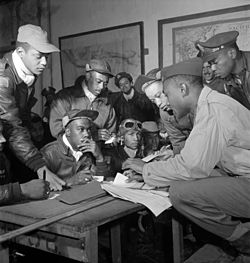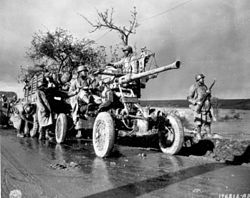African Americans Combat Troops in Italy
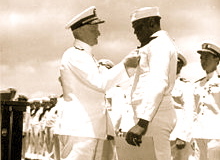
World War II- Combat Troops in Italy circa 1944
Black Soldiers face enemy resistance in Italy as the Allies attacked the German Gothic Line.
World War II
We call upon the president and congress to declare war on Japan and racial prejudice in our country. Certainly we should be strong enough to whip them both, The Pittsburgh Courier
 Admiral Chester W. Nimitz pins Navy Cross on Doris Miller, at ceremony on board warship in Pearl Harbor, 27 May 1942
Admiral Chester W. Nimitz pins Navy Cross on Doris Miller, at ceremony on board warship in Pearl Harbor, 27 May 1942
Despite a high enlistment rate in the U.S. Army, African Americans were not treated equally. Racial tensions existed. At parades, church services, in transportation and canteens the races were kept separate.
Many soldiers of color served their country with distinction during World War II. There were 125,000 African Americans who were overseas in World War II. Famous segregated units, such as the Tuskegee Airmen and 761st Tank Battalion and the lesser-known but equally distinguished 452nd Anti-Aircraft Artillery Battalion proved their value in combat, leading to desegregation of all U.S. Armed Forces by order of President Harry S. Truman in July 1948 via Executive Order 9981.
Benjamin O. Davis, Jr. served as commander of the famed Tuskegee Airmenduring the War. He later went on to become the first African American general in the United States Air Force. His father, Benjamin O. Davis, Sr., had been the first African American Brigadier General in the Army (1940).
Doris Miller, a Navy mess attendant, was the first African American recipient of the Navy Cross, awarded for his actions during the attack on Pearl Harbor. Miller had voluntarily manned an anti-aircraft gun and fired at the Japanese aircraft, despite having no prior training in the weapon’s use.
In 1944, the Golden Thirteen became the Navy’s first African American commissioned officers. Samuel L. Gravely, Jr. became a commissioned officer the same year; he would later be the first African American to command a US warship, and the first to be an admiral.
The Port Chicago disaster on July 17, 1944, was an explosion of about 2,000 tons of ammunition as it was being loaded onto ships by black Navy soldiers under pressure from their white officers to hurry. The explosion in Northern California killed 320 military and civilian workers, most of them black. The aftermath led to the Port Chicago Mutiny, the only case of a full military trial for mutiny in the history of the U.S. Navy against 50 Afro-American sailors who refused to continue loading ammunition under the same dangerous conditions. The trial was observed by the then young lawyer Thurgood Marshall and ended in conviction of all of the defendants. The trial was immediately and later criticized for not abiding by the applicable laws on mutiny, and it became influential in the discussion of desegregation.
During World War II, most African American soldiers still served only as truck drivers and as stevedores (except for some separate tank battalions and Army Air Forces escort fighters). In the midst of the Battle of the Bulge in December 1944, General Eisenhower was severely short of replacement troops for existing military units which were totally white in composition. Consequently, he made the decision to allow African American soldiers to pick up a weapon and join the white military units to fight in combat for the first time. More than 2,000 black soldiers had volunteered to go to the front. This was an important step toward a desegregated United States military. A total of 708 African Americans were killed in combat during World War II.
In 1945, Frederick C. Branch became the first African-American United States Marine Corps officer.
Units
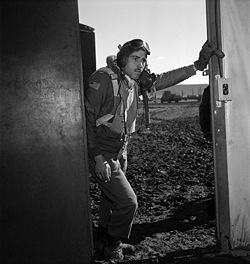 The Tuskegee Airmen were the first African-American pilots in United States military history; they flew with distinction during World War II. Portrait of Tuskegee airman Edward M. Thomas by photographer Toni Frissell, March 1945.
The Tuskegee Airmen were the first African-American pilots in United States military history; they flew with distinction during World War II. Portrait of Tuskegee airman Edward M. Thomas by photographer Toni Frissell, March 1945.
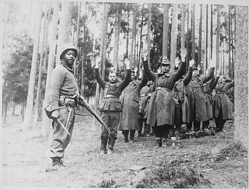 12th AD soldier with German prisoners of war, April 1945.
12th AD soldier with German prisoners of war, April 1945.
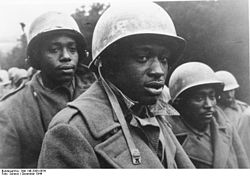 Americans captured during the Battle of the Bulge, December 1944
Americans captured during the Battle of the Bulge, December 1944
Some of the most notable African American Army units which served in World War II were:
- 92nd Infantry Division
- 93rd Infantry Division
- 2nd Cavalry Division
- Air Corps Units
- Non Divisional Units
- Anti-Aircraft Artillery Unit
- Infantry Units
- Cavalry/Armor Units
- Field Artillery Units
- 46th Field Artillery Brigade.
- 184th Field Artillery Regiment, Illinois National Guard.
- 333rd Field Artillery Regiment.
- 349th Field Artillery Regiment
- 350th Field Artillery Regiment
- 351st Field Artillery Regiment
- 353rd Field Artillery Regiment
- 578th Field Artillery Regiment
- 333rd Field Artillery Battalion
- 349th Field Artillery Battalion
- 350th Field Artillery Battalion
- 351st Field Artillery Battalion
- 353rd Field Artillery Battalion
- 578th Field Artillery Battalion
- 593rd Field Artillery Battalion
- 594th Field Artillery Battalion
- 595th Field Artillery Battalion
- 596th Field Artillery Battalion
- 597th Field Artillery Battalion
- 598th Field Artillery Battalion
- 599th Field Artillery Battalion
- 600th Field Artillery Battalion
- 686th Field Artillery Battalion
- 777th Field Artillery Battalion
- 795th Field Artillery Battalion
- 930th Field Artillery Battalion, Illinois National Guard
- 931st Field Artillery Battalion, Illinois National Guard
- 969th Field Artillery Battalion
- 971st Field Artillery Battalion
- 973rd Field Artillery Battalion
- 993rd Field Artillery Battalion
- 999th Field Artillery Battlaion
- Tank Destroyer Units
- 614th Tank Destroyer Battalion
- 646th Tank Destroyer Battalion
- 649th Tank Destroyer Battalion
- 659th Tank Destroyer Battalion
- 669th Tank Destroyer Battalion
- 679th Tank Destroyer Battalion
- 795th Tank Destroyer Battalion
- 827th Tank Destroyer Battalion
- 828th Tank Destroyer Battalion
- 829th Tank Destroyer Battalion
- 846th Tank Destroyer Battalion
Two segregated units were organized by the United States Marine Corps:

